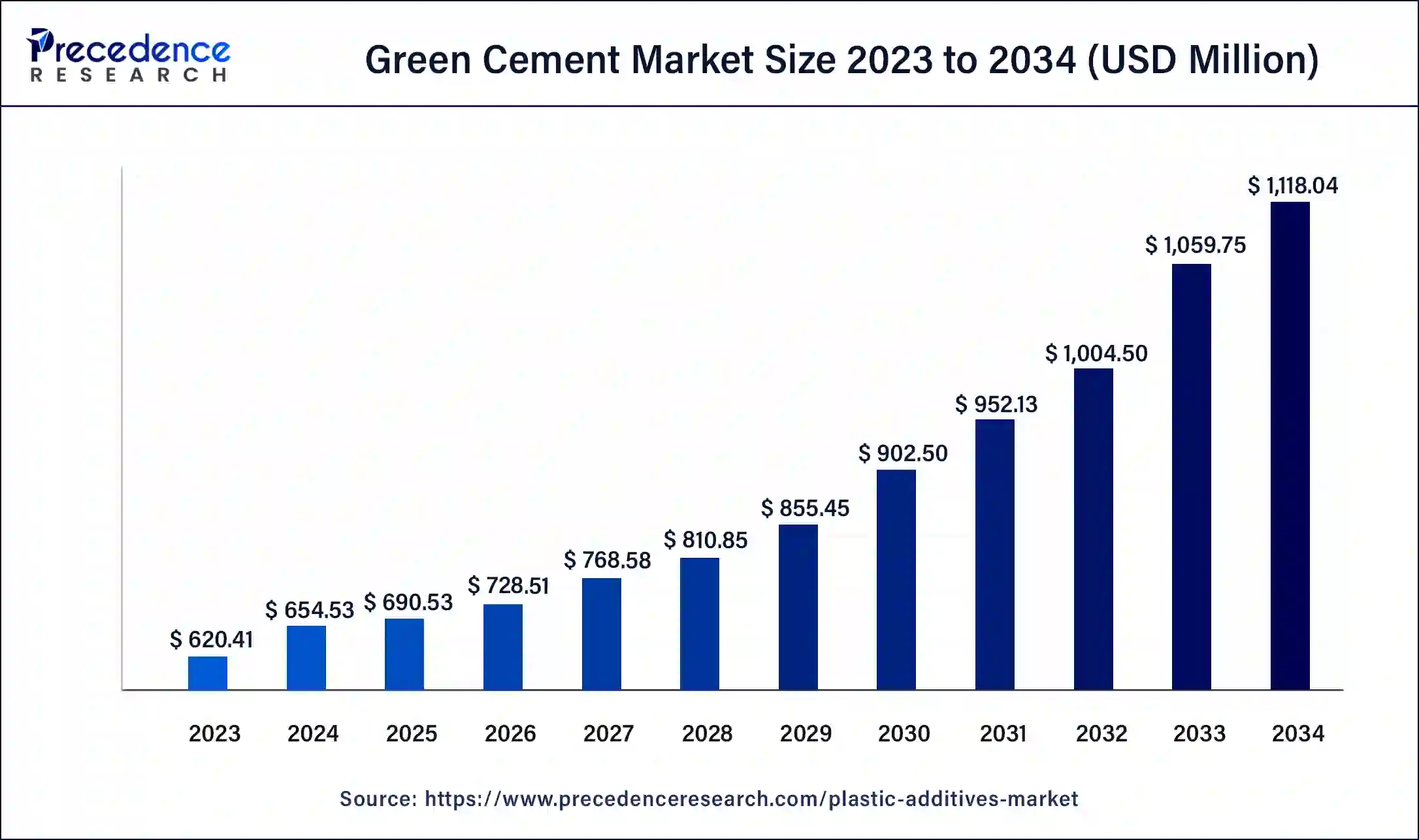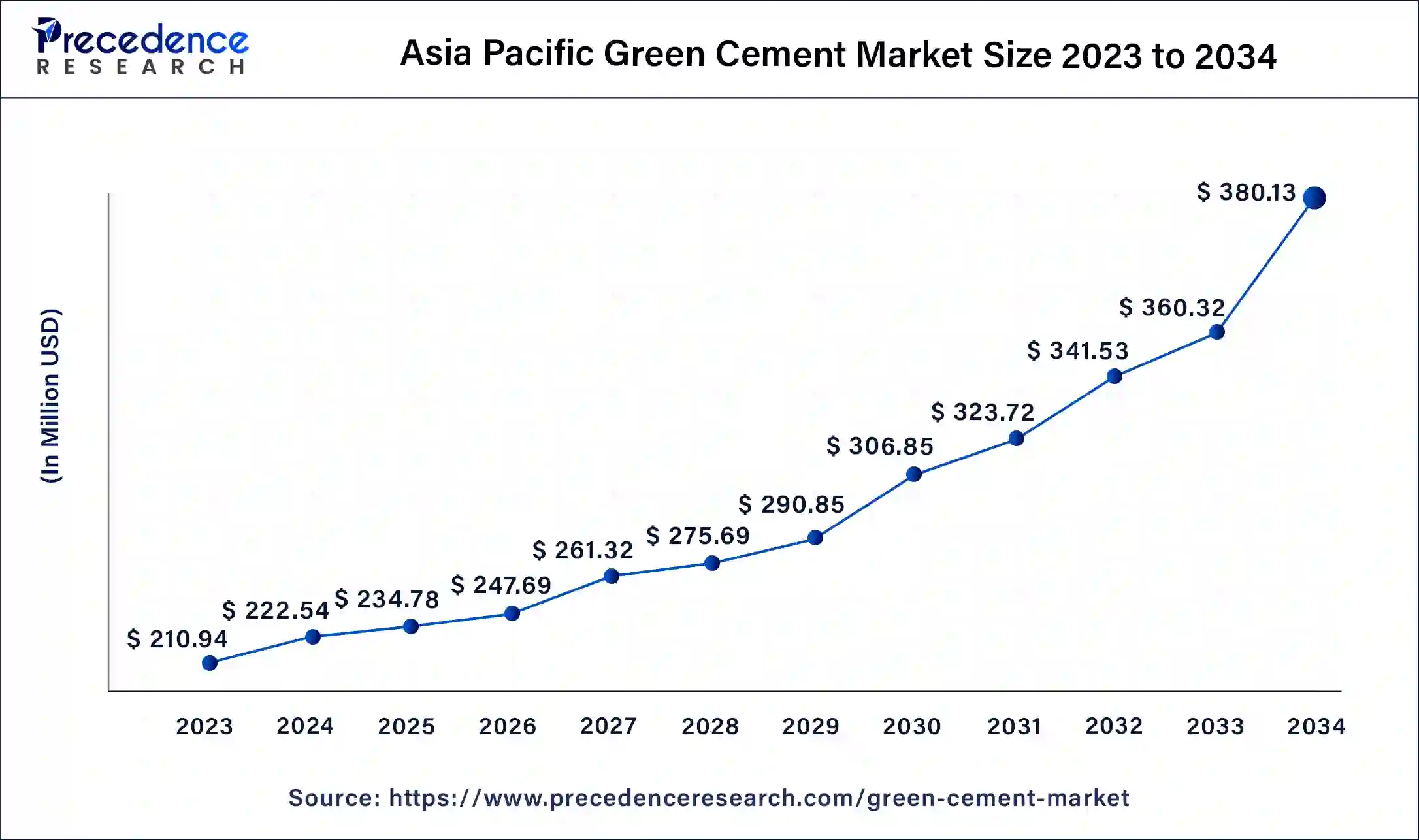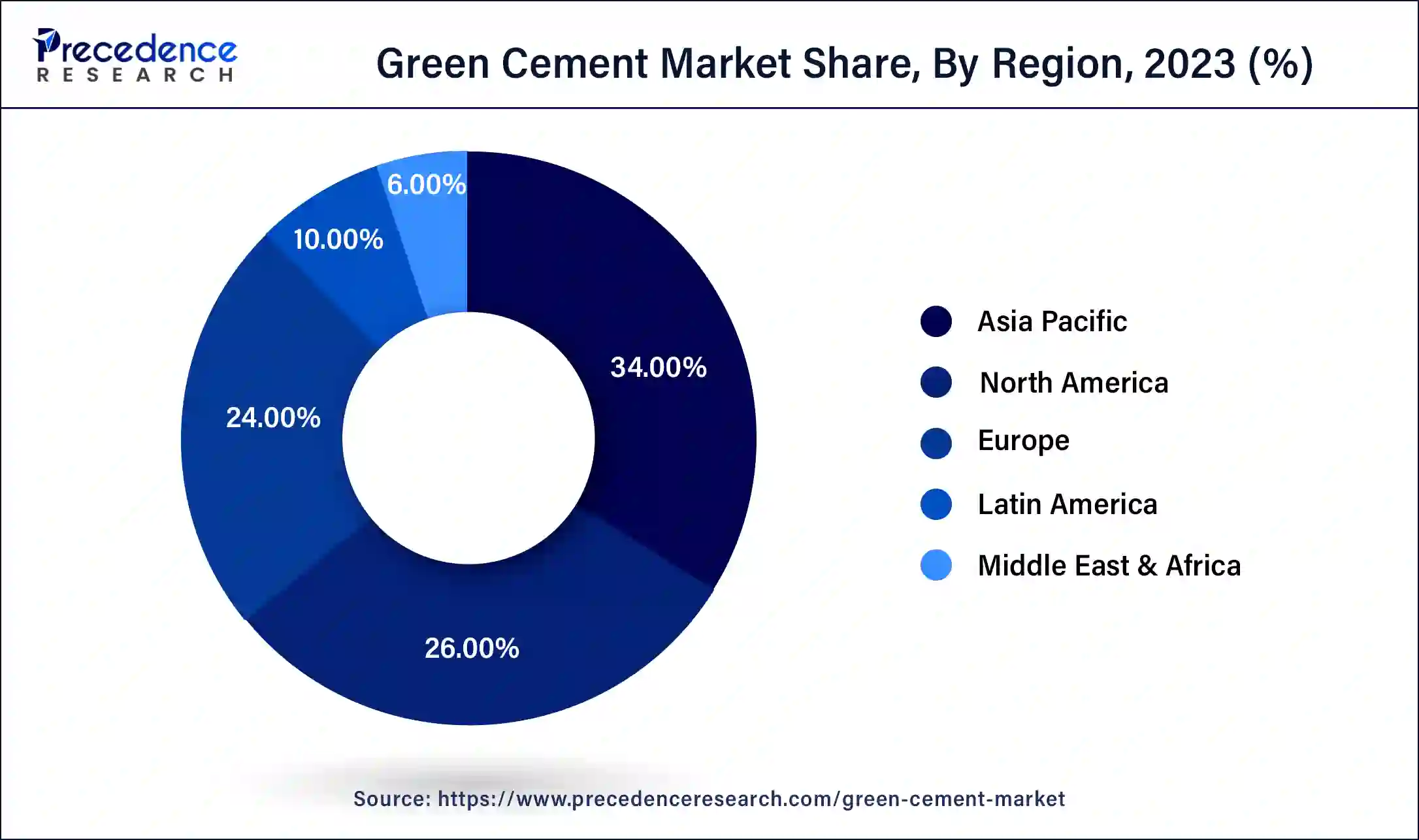December 2024
Green Cement Market (By Product: Fly-ash Based, Slag Based, Recycled Aggregates; By Application: Commercial, Residential) - Global Industry Analysis, Size, Share, Growth, Trends, Regional Outlook, and Forecast 2024-2034
The global green cement market size was USD 620.41 million in 2023, accounted for USD 654.53 million in 2024, and is expected to reach around USD 1,118.04 million by 2034, expanding at a CAGR of 5.5% from 2024 to 2034. Rising environmental concern over the increasing construction activities are driving the growth of the green cement market.

The Asia Pacific green cement market size was estimated at USD 210.94 million in 2023 and is predicted to be worth around USD 380.13 million by 2034, at a CAGR of 5.7% from 2024 to 2034.

Asia-Pacific led the global market with the highest market share of 34% in 2023. Governments and regulatory bodies in Asia Pacific are implementing stringent environmental regulations and sustainability initiatives to address air pollution, carbon emissions, and climate change. Green cement, also known as low-carbon or eco-friendly cement, offers reduced carbon footprint and lower environmental impact compared to traditional Portland cement. This aligns with the region's sustainability goals and regulatory requirements, driving demand for green cement in construction projects. Asia Pacific is rich in natural resources such as limestone, clay, and gypsum, which are key ingredients in cement production. The availability of locally sourced raw materials reduces transportation costs and environmental footprint associated with cement manufacturing, making green cement a viable and cost-effective alternative for construction projects in the region.

North America is expected to witness the fastest rate of growth in the green cement market during the forecast period. The rising environmental concerns in the region are observed to create a significant opportunity for the application of green cement in the region. The United States and Canada, being the most lucrative marketplaces in North America green cement market, are observed to contribute to the industry with the development of advanced products for the construction sector.
The green cement market offers sustainable or eco-friendly cement, refers to a type of cementitious material that is produced using environmentally friendly manufacturing processes and raw materials, with the goal of reducing carbon emissions and environmental impact compared to traditional Portland cement. Green cement is characterized by its lower carbon footprint, energy efficiency, and use of alternative materials and technologies to minimize environmental harm throughout its lifecycle.
The green cement market to reduce the carbon footprint associated with cement production, which is one of the largest sources of greenhouse gas emissions globally. Manufacturers employ various strategies to lower carbon emissions, such as using alternative fuels, optimizing kiln processes, and incorporating supplementary cementitious materials (SCMs) like fly ash, slag, or calcined clay.
The green cement market represents a significant shift towards more sustainable and environmentally friendly practices within the construction industry. By embracing green cement technologies and solutions, stakeholders can contribute to reducing carbon emissions, conserving natural resources, and creating more resilient and sustainable built environments for future generations.
| Report Coverage | Details |
| Growth Rate from 2024 to 2034 | CAGR of 5.5% |
| Global Market Size in 2023 | USD 620.41 Million |
| Global Market Size in 2024 | USD 654.53 Million |
| Global Market Size by 2034 | USD 1,118.04 Million |
| Largest Market | Asia Pacific |
| Base Year | 2023 |
| Forecast Period | 2024 to 2034 |
| Segments Covered | By Product and By Application |
| Regions Covered | North America, Europe, Asia-Pacific, Latin America, and Middle East & Africa |
Increasing construction activities
Rising construction activities in developing countries act as a major driver for the green cement market. With growing concerns about climate change and environmental sustainability, there is a rising demand for construction materials that have a lower carbon footprint and contribute to reducing greenhouse gas emissions. Green cement, also known as sustainable or eco-friendly cement, offers a more environmentally friendly alternative to traditional Portland cement by incorporating recycled materials, alternative fuels, and innovative production processes.
Governments and regulatory bodies worldwide are implementing stricter regulations and standards aimed at reducing carbon emissions and promoting sustainable construction practices. Many regions have introduced building codes, green building certifications (e.g., LEED, BREEAM), and environmental performance requirements that incentivize or mandate the use of low-carbon construction materials, including green cement. Compliance with these regulations drives the adoption of green building solutions in construction projects.
Lack of product awareness
Green cement is a relatively new and innovative product in the construction industry, offering environmental benefits such as reduced carbon emissions and energy consumption compared to traditional Portland cement. However, the lack of awareness about green cement among contractors, architects, engineers, and other stakeholders hinders its widespread adoption and market penetration. Many construction professionals may be unfamiliar with the availability, benefits, and applications of green cement, leading to a preference for conventional cement products.
The lack of product awareness may result in insufficient training and knowledge gaps among contractors, builders, and construction workers, limiting their ability to effectively utilize green cement in projects. Education and awareness campaigns are essential to address this barrier and ensure that stakeholders are equipped with the necessary knowledge and skills to use green cement effectively.
Rising investment for developing the eco-friendly options
Increasing investment on the R&D activities for developing an alternative eco-friendly option for cement with the enhanced quality, flexibility, durability, and compatibility in different type of construction projects. Rising trends for the sustainable products drives the demand for the green cement and the rising awareness among people about their health and environmental condition due to the excessive carbon emission are emphasizing the demand for the development of green cement as an alternative to the traditional chemical-based cement. Thus, all these ongoing factors are contributing to the future potential for the green cement market.
The fly ash-based green cement dominated the green cement market in 2023. The dominance of the segment is attributed to the rising adoption of fly ash cement for minimizing the waste and decrease the carbon emission which drives the growth of the segment in the market. Fly-ash blending offers many benefits in terms of consumption of water, higher durability, and mechanical properties. Fly-ash cuts down the water requirement in concrete, enhances workability, and pumping ability. The fly-ash gives better strength compared to OPC. Fly-ash reduces the chloride and water permeability at later stages, and significantly increases the resistance to sulphate attack.
Vedanta Limited’s Aluminum business, whose aluminum smelters are powered by mammoth thermal power operations, announced to collaborate with cement producers. The company uses the high-quality of coal at their power plants and produces low-sulphur, good quality fly-ash that is perfectly suitable for the manufacturing of cement, bricks, roads, and infrastructural industries.
The slag-based green cement segment is expected to grow at a significant rate in the green cement market during the forecast period. The growth of the segment is attributed to the rising used of slag-based cement as an alternative to the traditional cement due to it reduces the greenhouse gas emission by 95% and 8% of the global greenhouse gas emission from the concrete manufacturing. Considering the rising concerns over greenhouse emission act as a major driver for the segment’s growth in the market.
The commercial segment dominated the green cement market with the largest share in 2023. With increasing concerns about climate change and environmental sustainability, there is a growing demand for construction materials that have minimal environmental impact. Green cement, also known as sustainable or eco-friendly cement, addresses this need by reducing carbon emissions and resource consumption during production. Commercial developers and builders, as well as government agencies, are increasingly prioritizing green building practices to meet sustainability goals and regulatory requirements.
Green buildings constructed with sustainable materials, including green cement, offer numerous benefits such as energy efficiency, indoor air quality, and occupant comfort. Developers and building owners recognize the market value and competitive advantage of green buildings, which command higher rental rates, sales prices, and occupancy levels compared to conventional buildings. Incorporating green cement into commercial projects allows developers to differentiate their properties in the market and attract environmentally conscious tenants and occupants.
The residential segment is expected to be the most lucrative segment of the green cement market during the forecast period. Green cement can contribute to energy efficiency and thermal performance in residential buildings, leading to reduced heating and cooling costs for homeowners. Certain types of green cement, such as fly ash cement and slag cement, have superior insulating properties and can help regulate indoor temperatures by reducing heat transfer through walls and floors. This energy-saving attribute enhances comfort and livability in residential spaces, driving demand for green cement.
Segments Covered in the Report
By Product
By Application
By Geography
For inquiries regarding discounts, bulk purchases, or customization requests, please contact us at sales@precedenceresearch.com
No cookie-cutter, only authentic analysis – take the 1st step to become a Precedence Research client
December 2024
January 2025
November 2024
November 2023